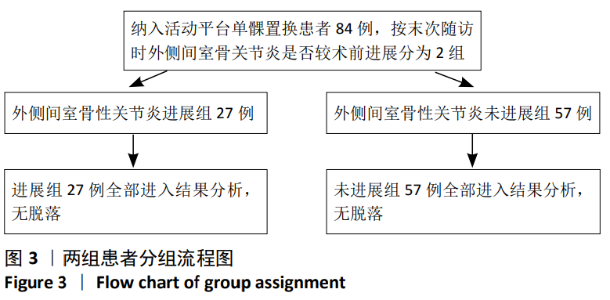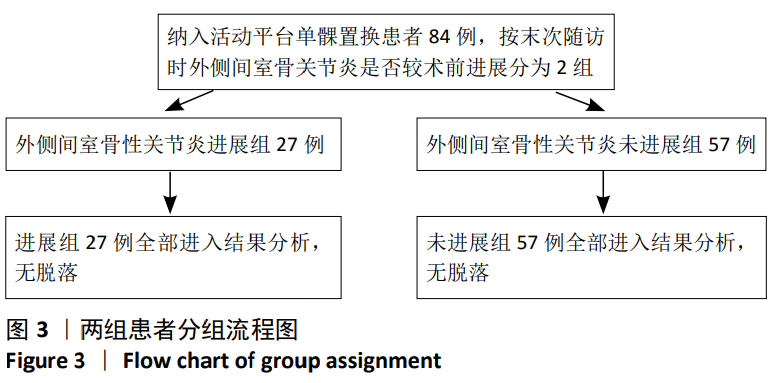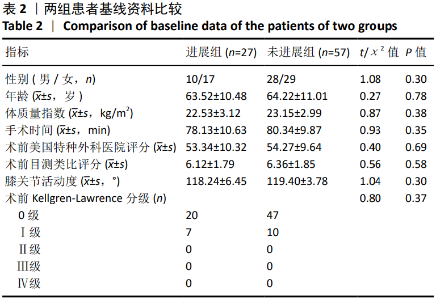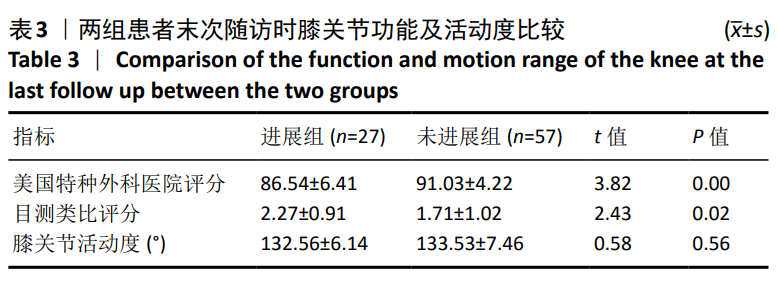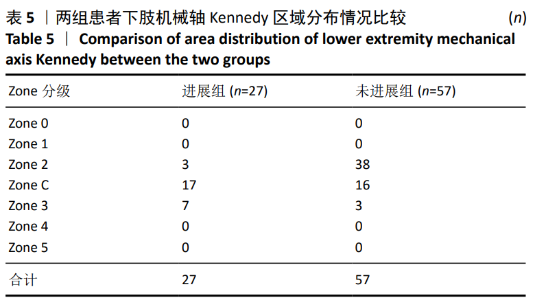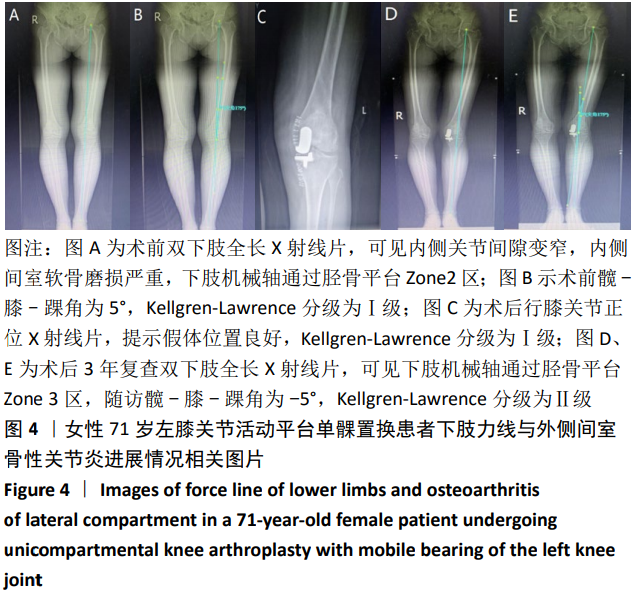Chinese Journal of Tissue Engineering Research ›› 2021, Vol. 25 ›› Issue (9): 1368-1374.doi: 10.3969/j.issn.2095-4344.3762
Previous Articles Next Articles
Relationship of lower limb force line and the progression of lateral compartment arthritis after unicompartmental knee arthroplasty with mobile bearing
Peng Zhihao1, 2, Feng Zongquan1, Zou Yonggen1, Niu Guoqing1, 2, Wu Feng1, 2
- 1Foshan Hospital of Traditional Chinese Medicine Affiliated to Guangzhou University of Chinese Medicine, Foshan 528000, Guangdong Province, China; 2Sixth Department of Orthopedics, Foshan Hospital of Traditional Chinese Medicine, Foshan 528000, Guangdong Province, China
-
Received:2020-05-06Revised:2020-05-12Accepted:2020-06-09Online:2021-03-28Published:2020-12-15 -
Contact:Peng Zhihao, Associate chief physician, Foshan Hospital of Traditional Chinese Medicine Affiliated to Guangzhou University of Chinese Medicine, Foshan 528000, Guangdong Province, China; Sixth Department of Orthopedics, Foshan Hospital of Traditional Chinese Medicine, Foshan 528000, Guangdong Province, China -
About author:Peng Zhihao, Associate chief physician, Foshan Hospital of Traditional Chinese Medicine Affiliated to Guangzhou University of Chinese Medicine, Foshan 528000, Guangdong Province, China; Sixth Department of Orthopedics, Foshan Hospital of Traditional Chinese Medicine, Foshan 528000, Guangdong Province, China
CLC Number:
Cite this article
Peng Zhihao, Feng Zongquan, Zou Yonggen, Niu Guoqing, Wu Feng. Relationship of lower limb force line and the progression of lateral compartment arthritis after unicompartmental knee arthroplasty with mobile bearing[J]. Chinese Journal of Tissue Engineering Research, 2021, 25(9): 1368-1374.
share this article
| [1] BRUCE DJ, HASSABALLA M, ROBINSON JR, et al. Minimum 10-year outcomes of a fixed bearing all-polyethylene unicompartmental knee arthroplasty used to treat medial osteoarthritis. Knee. 2020;24(3): 1437-1441. [2] CAO Z, NIU C, GONG C, et al. Comparison of fixed-bearing and mobile-bearing unicompartmental knee arthroplasty: a systematic review and meta-analysis. J Arthroplasty. 2019;34(12):1-10. [3] 沙宇,韩晓峰,胡彬,等.活动平台与固定平台单髁置换术后下肢力线的矫正效果比较[J].骨科临床与研究杂志,2019,4(6):329-332. [4] 卢明峰,胡广兵,李泽晖,等. LINK 固定平台与 Oxford 活动平台单髁置换治疗膝内侧单间室骨性关节炎的对比[J].中国组织工程研究,2017,21(35):5595-5602. [5] HERNIGOU P, DESCHAMPS G. Alignment influences wear in the knee after medial unicompartmental arthroplasty. Clin Orthop Relat Res. 2004;423(423):161-165. [6] KENNEDY JA, MOLLOY J, JENKINS C, et al. Functionaloutcome and revision rate are independent of limb alignment following Oxford medial unicompartmental knee replacement. J Bone Joint Surg Am. 2019;101(3):270-275. [7] INOUE A,ARAI Y,NAKAGAWA S, et al. Comparison of Alignment Correction Angles Between Fixed-Bearing and Mobile-Bearing UKA. J Arthroplasty. 2016;31(1):142-145. [8] DYRHOVDEN GS, LYGRE SHL, BADAWY M, et al. Have the causes of revision for total and unicompartmental knee arthroplasties changed during the past two decades? Clin Orthop Relat Res. 2017;475(7): 1874-1886. [9] EPINETTE JA, BRUNSCHWEILER B, MERTL P, et al. French Society forHip and Knee. Unicompartmental knee arthroplasty modes of failure: wear is not the main reason for failure: a multicentre study of 418 failed knees. Orthop Traumatol Surg Res. 2012;98(6 Suppl):124-130. [10] VAN DER LIST JP,ZUIDERBAAN HA,PEARLE AD. Why Do Medial Unicompartmental Knee Arthroplasties Fail Today? J Arthroplasty. 2016;31(5):1016-1021. [11] LABRUYÈRE C, ZELLER V, LHOTELLIER L, et al. Chronic infection of unicompartmental knee arthroplasty: One-stage conversion to total knee arthroplasty. Orthop Traumatol Surg Res. 2015;101(5):553-557. [12] KOZINN SC, SCOTT R. Unicondylar knee arthroplasty.J Bone Joint Surg Am. 1989;71(1):145-150. [13] KUMAR H, PAL CP, SHARMA YK, et al. Epidemiology of knee osteoarthritis using Kellgren and Lawrence scale in Indian population. J Clin Orthop Trauma.2020;11(Suppl 1):125-129. [14] RANAWAT CS, INSALL J, SHINE J. Duo-condylar knee arthroplasty: hospital for special surgery design. Clin Orthop Relat Res. 1976;10(120): 76-82. [15] PRICE DD. The validation of visual analogue scales as ratio scale measures for chronic and experimental pain. Pain.1983;17(1):45-56. [16] KENNEDY WR, WHITE RP. Unicompartmental arthroplasty of the knee: postoperative alignment and its influence on overall results. Clin Orthop Relat Res. 1987;221(21):278-285. [17] KIEVIT AJ, KUIJER PP, DE HAAN LJ, et al. Patients return to work sooner after unicompartmental knee arthroplasty than after total knee arthroplasty. Knee Surg Sports Traumatol Arthrosc. 2019;30(8):1-12. [18] 柯鹏辉,尹宗生,陆鸣,等. 单髁与全膝关节置换术后步态与平衡能力比较[J].中华关节外科杂志(电子版),2020,14(1):11-16. [19] 王冰,于秀淳,孙海宁,等.牛津人工单髁关节置换假体生存分析及并发症处理策略[J].中华关节外科杂志(电子版),2018,12(5): 631-637. [20] ISAAC SM, BARKER KL, DANIAL IN, et al. Does arthroplasty type influence knee joint proprioception? A longitudinal prospective study comparing total and unicompartmental arthroplasty. Knee.2007;14(3): 212-217. [21] FORNELL S, PRADA E, BARRENA P, et al. Mid-term outcomes of mobile-bearing lateral unicompartmental knee arthroplasty. Knee. 2018;25(6): 1206-1213. [22] 吴东,杨敏之,曹正,等. 膝关节单髁置换术研究进展[J].中国修复重建外科杂志,2020,34(2):1-6. [23] LYONS MC, MACDONALD SJ, SOMERVILLE LE, et al. Unicompartmental versus total knee arthroplasty database analysis: is there a winner? Clin Orthop Relat Res. 2012;470(1):84-90. [24] LIM JW, COUSINS GR, CLIFT BA, et al. Oxford unicompartmental knee arthroplasty versus age and gender matched total knee arthroplasty-functional outcome and survivorship analysis. J Arthroplasty. 2014; 29(8):1779-1783. [25] VAN DER LIST JP, CHAWLA H, ZUIDERBAAN HA, et al. The role of preoperative patient characteristics on outcomes of unicompartmental knee arthroplasty:a meta-analysis critique. J Arthroplasty. 2016;31(11): 2617-2627. [26] LEWIS PL, GRAVES SE, DE STEIGER RN, et al. Does knee prosthesis survivorship improve when implant designs change? Findings from the australian orthopaedic association national joint replacement registry. Clin Orthop Relat Res. 2020;478(6):1156-1172. [27] SAWATARI T, TSUMURA H, IESAKA K, et al. Three-dimensional finite element analysis of unicompartmental knee arthroplasty-The influence of tibial component inclination. J Orthop Res.2005;23(3):549-554. [28] ZHU GD, GUO WS, ZHANG QD, et al. Finite element analysis of mobile-bearing unicompartmental knee arthroplasty: The influence of tibial component coronal alignment. Chin Med J.2015;128(21):2873-2878. [29] CHATELLARD R, SAULEAU V, COLMAR M, et al. Medial unicompartmental knee arthroplasty: does tibial component position influence clinical outcomes and arthroplasty survival? Orthop Traumatol Surg Res. 2013; 99(4 Suppl):S219–S225. [30] BOLOGNESI MP, MARCHANT MH, VIENS NA, et al. The impact of diabetes on perioperative patient outcomes after total hip and total knee arthroplasty in the United States. J Arthroplasty. 2008;23 (6 Suppl 1):92-98. [31] PANDIT H, MANCUSO F, JENKINS C, et al. Lateral unicompartmental knee replacement for the treatment of arthritis progression after medial unicompartmental replacement. Knee Surg Sports Traumatol Arthrosc.2017;25(3):669-674. [32] 万伏银,郭万首.外侧间室软骨退变程度在内侧单髁关节置换中的重要地位及其术前评价方法[J].中华骨与关节外科杂志, 2019, 12(10):821-825. [33] DOWN C, XU Y, OSAGIE LE, et al. The lack of correlation between radiographic findings and cartilage integrity. J Arthroplasty.2011;26(6): 949-954. [34] MOEN TC, LASKIN W, PURI L. The lateral compartment in knees with isolated medial and patellofemoral osteoarthritis:a histologic analysis of articular cartilage. J Arthroplasty.2011;26(6):783-787. [35] WALDSTEIN W, SCHMIDT-BRAEKLING T, PERINO G, et al. Valgus stress radiographs predict lateral-compartment cartilage thickness but not cartilage degeneration in varus osteoarthritis. J Arthroplasty.2017; 32(3):788-792. [36] 梁钰琪,牛东生,李立新,等. 膝关节外侧间室软骨退变对膝关节内侧单髁置换手术的影响[J].中国骨与关节损伤杂志,2017,32(4): 354-356. [37] CHENG T, CHEN D, ZHU C, et al. Fixed- versus mobile-bearing unicondylar knee arthroplasty: are failure modes different? Knee Surg Sports Traumatol Arthrosc.2013;21(11):2433-2441. [38] ANDRIACCHI TP. Dynamics of knee malalignment. Orthop Clin North Am. 1994;25(3):395-403. [39] WEN PF, GUO WS, GAO FQ, et al. Effects of Lower Limb Alignment and Tibial Component Inclination on the Biomechanics of Lateral Compartment in Unicompartmental Knee Arthroplasty. Chinese Medical J. 2017;130(21):2563. [40] VASSO M, DEL REGNO C,D’AMELIO A, et al. Minor varus alignment provides better results than neutral alignment in medial UKA. The Knee.2015;22(2):117-121. [41] ZUIDERBAAN HA, VAN DER LIST JP, CHAWLA H, et al. Predictors of subjective outcome after medial unicompartmental knee arthroplasty. J Arthroplasty. 2016;31(7):1453-1458. [42] SLAVEN SE, CODY JP, SERSHON RA, et al. The impact of coronal alignment on revision in medial fixed-bearing unicompartmental knee arthroplasty. J Arthroplasty. 2020;35(2):353-357. [43] KENNEDY JA, MOLLOY J, JENKINS C, et al. Functional outcome and revision rate are independent of limb alignment following oxford medial unicompartmental knee replacement. J Bone Joint Surg. 2019; 101(3):270-275. |
| [1] | Huang Dengcheng, Wang Zhike, Cao Xuewei. Comparison of the short-term efficacy of extracorporeal shock wave therapy for middle-aged and elderly knee osteoarthritis: a meta-analysis [J]. Chinese Journal of Tissue Engineering Research, 2021, 25(9): 1471-1476. |
| [2] | Jiang Yong, Luo Yi, Ding Yongli, Zhou Yong, Min Li, Tang Fan, Zhang Wenli, Duan Hong, Tu Chongqi. Von Mises stress on the influence of pelvic stability by precise sacral resection and clinical validation [J]. Chinese Journal of Tissue Engineering Research, 2021, 25(9): 1318-1323. |
| [3] | Zhang Yu, Tian Shaoqi, Zeng Guobo, Hu Chuan. Risk factors for myocardial infarction following primary total joint arthroplasty [J]. Chinese Journal of Tissue Engineering Research, 2021, 25(9): 1340-1345. |
| [4] | Li Dadi, Zhu Liang, Zheng Li, Zhao Fengchao. Correlation of total knee arthroplasty efficacy with satisfaction and personality characteristics [J]. Chinese Journal of Tissue Engineering Research, 2021, 25(9): 1346-1350. |
| [5] | Wei Wei, Li Jian, Huang Linhai, Lan Mindong, Lu Xianwei, Huang Shaodong. Factors affecting fall fear in the first movement of elderly patients after total knee or hip arthroplasty [J]. Chinese Journal of Tissue Engineering Research, 2021, 25(9): 1351-1355. |
| [6] | Wang Jinjun, Deng Zengfa, Liu Kang, He Zhiyong, Yu Xinping, Liang Jianji, Li Chen, Guo Zhouyang. Hemostatic effect and safety of intravenous drip of tranexamic acid combined with topical application of cocktail containing tranexamic acid in total knee arthroplasty [J]. Chinese Journal of Tissue Engineering Research, 2021, 25(9): 1356-1361. |
| [7] | Zhang Shangpu, Ju Xiaodong, Song Hengyi, Dong Zhi, Wang Chen, Sun Guodong. Arthroscopic suture bridge technique with suture anchor in the treatment of acromioclavicular dislocation [J]. Chinese Journal of Tissue Engineering Research, 2021, 25(9): 1417-1422. |
| [8] | Yuan Jiawei, Zhang Haitao, Jie Ke, Cao Houran, Zeng Yirong. Underlying targets and mechanism of Taohong Siwu Decoction in prosthetic joint infection on network pharmacology [J]. Chinese Journal of Tissue Engineering Research, 2021, 25(9): 1428-1433. |
| [9] | Chen Junming, Yue Chen, He Peilin, Zhang Juntao, Sun Moyuan, Liu Youwen. Hip arthroplasty versus proximal femoral nail antirotation for intertrochanteric fractures in older adults: a meta-analysis [J]. Chinese Journal of Tissue Engineering Research, 2021, 25(9): 1452-1457. |
| [10] | Liu Yafei, Wang Yalin, Zuo Yanping, Sun Qi, Wei Jing, Zhao Lixia. Structural changes of the temporomandibular joint in adolescents with skeletal Class III malocclusions after maxillary protraction: an X-ray measurement analysis [J]. Chinese Journal of Tissue Engineering Research, 2021, 25(8): 1154-1159. |
| [11] | Wu Xun, Meng Juanhong, Zhang Jianyun, Wang Liang. Concentrated growth factors in the repair of a full-thickness condylar cartilage defect in a rabbit [J]. Chinese Journal of Tissue Engineering Research, 2021, 25(8): 1166-1171. |
| [12] | Geng Qiudong, Ge Haiya, Wang Heming, Li Nan. Role and mechanism of Guilu Erxianjiao in treatment of osteoarthritis based on network pharmacology [J]. Chinese Journal of Tissue Engineering Research, 2021, 25(8): 1229-1236. |
| [13] | Liu Xiangxiang, Huang Yunmei, Chen Wenlie, Lin Ruhui, Lu Xiaodong, Li Zuanfang, Xu Yaye, Huang Meiya, Li Xihai. Ultrastructural changes of the white zone cells of the meniscus in a rat model of early osteoarthritis [J]. Chinese Journal of Tissue Engineering Research, 2021, 25(8): 1237-1242. |
| [14] | Yuan Jun, Yang Jiafu. Hemostatic effect of topical tranexamic acid infiltration in cementless total knee arthroplasty [J]. Chinese Journal of Tissue Engineering Research, 2021, 25(6): 873-877. |
| [15] | Zhang Lei, Ma Li, Fu Shijie, Zhou Xin, Yu Lin, Guo Xiaoguang. Arthroscopic treatment of greater tuberosity avulsion fractures with anterior shoulder dislocation using the double-row suture anchor technique [J]. Chinese Journal of Tissue Engineering Research, 2021, 25(6): 895-900. |
| Viewed | ||||||
|
Full text |
|
|||||
|
Abstract |
|
|||||
